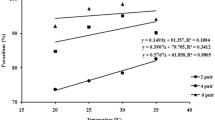Abstract
Telenomus remits Nixon is a parasitoid that attacks egg masses ofSpodoptera frugiperda (J.E. Smith). Increased host-seeking behavior was elicited fromT. remus females in Y-tubes, Petri dish, and greenhouse bioassays byS. frugiperda female abdominal tips as well as (Z)-9-tetradecene-1-ol acetate and (Z)-9-dodecene-1-ol acetate.
Similar content being viewed by others
References
Arthur, A.P. 1981. Host acceptance by parasitoids, pp. 97–120,in D.A. Nordlund, R.L. Jones, and W.J. Lewis (eds.). Semiochemicals: Their Role in Pest Control. Wiley, New York.
Burton, R.L. 1969. Mass rearing the corn earworm in the laboratory. USDA-ARS 33–134.
Corbet, S.A. 1971. Mandibular gland secretion of larvae of the flour moth,Anagasta kuehniella, contains an epideictic pheromone and elicits oviposition movements in a hymenopteran parasite.Nature 232:481–484.
Gerling, D. 1972. The developmental biology ofTelenomus remus Nixon (Hym., Scelionidae).Bull. Entomol. Res. 61:385–388.
Jones, R.L. 1981. Chemistry of semiochemicals involved in parasitoid-host and predatorprey relationships, pp. 239–250,in D.A. Nordlund, R.L. Jones, and W.J. Lewis (eds.). Semiochemicals: Their Role in Pest Control. Wiley, New York.
Jones, R.L., andSparks, A.N. 1979. (Z)-9-Tetradecen-1-ol acetate, a secondary sex pheromone of the fall armyworm,Spodoptera frugiperda, (J.E. Smith).J. Chem. Ecol. 5:721–725.
Kennedy, B.H. 1979. The effect of multilure on parasites of the European elm bark beetle,Scolytus multistriatus.Bull. Entomol. Soc. Am. 25:116–118.
Klun, J.A., Plimmer, J.R., Bierl-Leonhardt, B.A., Sparks, A.N., Primiani, M., Chapman, O.L., Lee, G.H., andLepone, G. 1980. Sex pheromone chemistry of female corn earworm,Heliothis zea.J. Chem. Ecol. 6:165–175.
Lewis, W.J., andRedlinger, L.M. 1969. Suitability of the almond moth,Cadra Cautella, of various ages for parasitism byTrichogramma evanescens.Ann. Entomol. Soc. Am. 62:1482–1484.
Lewis, W.J., Nordlund, D.A., Gueldner, R.C., Teal, P.E.A., andTumlinson, J.H. 1982. Kairomones and their use for management of entomophagous insects: XIII. Kairotnonal activity forTrichogramma spp. of abdominal tips, excretion, and a synthetic sex pheromone blend ofHeliothis zea (Boddie) moths.J. Chem. Ecol. 8:1323–1331.
Mitchell, E.R. 1979. Monitoring adult populations of the fall armyworm.Fla. Entomol. 62:91–98.
Mitchell, E.R., andDoolittle, R.E. 1976. Sex pheromone ofSpodoptera exigua, S. eridania, andS. frugiperda: Bioassay for field activity.J. Econ. Entomol. 69:324–326.
Perkins, W.D. 1979. Laboratory rearing of the fall armyworm.Fla. Entomol. 62:87–90.
Rice, R.E. 1969. Response of some predators and parasites ofIps confusus (Lec.) (Coleoptera: Scolytidae) to olfactory attractants.Contrib. Boyce Thompson Inst. 24:189–194.
Sekul, A.A., andCox, H.C. 1965. Sex pheromone in the fall armywormSpodoptera frugiperda (J.E. Smith).Bioscience 15:670–671.
Sekul, A.A., andSparks, A.N. 1967. Sex pheromone of the fall armyworm moth: Isolation, identification, and synthesis.J. Econ. Entomol 60:1270–1272.
Sparks, A.N. 1980. Pheromones: Potential for use in monitoring and managing populations of the fall armyworm.Fla. Entomol. 63:406–410.
Sternlicht, M. 1973. Parasitic wasps attracted by the sex pheromone of their coccid host.Entomophaga 18:339–342.
Vité, J.P., andWilliamson, D.L. 1970.Thanasimus dubius: Prey perception.J. Insect Physiol. 16:233–237.
Waddill, V.H., andWhitcomb, W.H. 1982. Release ofTelenomus remus (Hymenoptera: Scelionidae) againstSpodoptera frugiperda (Lepidoptera: Noctuidae) in Florida, USA.Entomophaga. In press.
Weseloh, R.M. 1981. Host location by parasitoids, pp. 79–95,in D.A. Nordlund, R.L. Jones, and W. J. Lewis (eds.). Semiochemicals: Their Role in Pest Control. Wiley, New York.
Wojcik, B., Whitcomb, W.H., andHabeck, D.H. 1976. Host range ofTelenomus remus (Hymenoptera: Scelionidae).Fla. Entomol. 59:195–198.
Author information
Authors and Affiliations
Additional information
Hymenoptera: Scelionidae.
Lepidoptera: Noctuidae.
In cooperation with the University of Georgia College of Agriculture Experiment Stations, Coastal Plain Station, Tifton, Georgia 31793. Accepted for publication October 19, 1982.
Mention of a proprietary product in this paper does not constitute an endorsement of the product by the USDA.
Rights and permissions
About this article
Cite this article
Nordlund, D.A., Lewis, W.J. & Gueldner, R.C. Kairomones and their use for management of entomophagous insects. J Chem Ecol 9, 695–701 (1983). https://doi.org/10.1007/BF00988776
Received:
Revised:
Issue Date:
DOI: https://doi.org/10.1007/BF00988776




